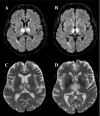Artery of Percheron Stroke: A Case Report
- PMID: 40641532
- PMCID: PMC12239187
- DOI: 10.15388/Amed.2025.32.1.14
Artery of Percheron Stroke: A Case Report
Abstract
Background: The Artery of Percheron (AOP) is a vascular variant supplying both sides of the thalamus, present in up to one-quarter of the general population. AOP occlusion is a rare cause of ischemic stroke, resulting in bilateral thalamic infarction. It typically manifests as altered consciousness, gaze abnormalities, and cognitive impairment. Neuroimaging of AOP stroke is challenging, as head CT is often unremarkable. However, a diagnostic 'V' sign can be identified on MRI. AOP stroke is treated as other types of ischemic stroke.
Case description: We present a case of a 61-year-old male with a history of alcohol abuse, diagnosed with ischemic AOP stroke. He presented with sudden loss of consciousness, third nerve palsy, and vertical gaze palsy. MRI revealed bilateral paramedian thalamic infarction with midbrain involvement. Despite conservative treatment, his condition showed minimal improvement, leaving him lethargic and dysarthric. He was discharged to palliative care after two weeks.
Conclusions: AOP infarction, though rare, should be considered in patients with altered consciousness. Early MRI is essential for accurate diagnosis and timely treatment, highlighting the importance of physician awareness of this condition.
Apžvalga: Peršerono arterija – tai gumburo kraujotakos variantas, kai abi gumburo puses maitina viena arterija. Ji gali būti aptinkama iki 25 proc. bendrosios populiacijos. Peršerono arterijos okliuzija yra labai reta išeminio insulto priežastis, sukelianti abipusį gumburo infarktą. Šis insultas paprastai pasireiškia sąmonės, akių judesių ir pažinimo funkcijų sutrikimu. Peršerono arterijos infarkto vaizdinimas yra sudėtingas, nes galvos KT dažnai būna be pakitimų. Tačiau galvos MRT galima matyti diagnostinį „V“ ženklą. Peršerono arterijos insultas gydomas kaip ir bet kurios kitos rūšies išeminis insultas.
Atvejo aprašymas: Į ligoninę paguldytas 61 metų vyras, vartojęs alkoholį, kuriam pasireiškė staigus sąmonės netekimas, trečiojo galvinio nervo paralyžius ir vertikalaus žvilgsnio paralyžius. MRT nustatytas abipusis paramedialinis gumburo infarktas su vidurinių smegenų pažeidimu. Pacientui diagnozuotas išeminis Peršerono arterijos insultas. Nepaisant konservatyvaus gydymo, pacientas išliko vangus ir dizartriškas. Po dviejų savaičių buvo išrašytas paliatyviajai slaugai.
Išvados: Nors Peršerono arterijos infarktas pasitaiko retai, apie jį reikėtų pagalvoti tiriant pacientus, kurių sąmonė būna sutrikusi. Ankstyvas MRT tyrimas yra labai svarbus šio tipo išeminio insulto diagnostikai ir gydymui laiku.
Keywords: artery of Percheron; ischemic stroke; midbrain; thalamic infarct.
Copyright © 2025 Milda Navickaitė, Aleksandras Vilionskis, Austėja Dapkutė, Kristina Ryliškienė. Published by Vilnius University Press.
Figures


References
LinkOut - more resources
Full Text Sources
